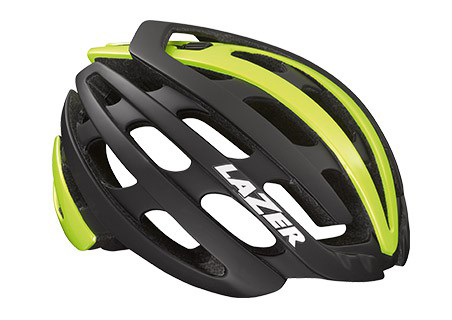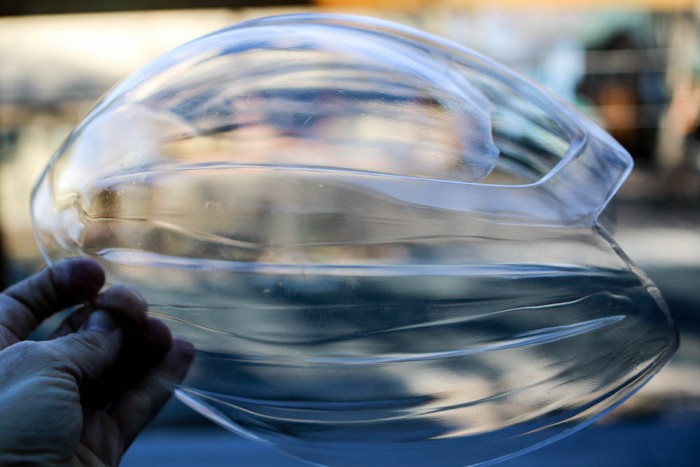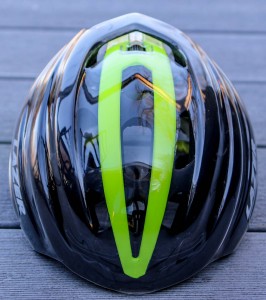[leadin]One of the best bike helmets we’ve reviewed, the Z1 is a top pick for hot and cold weather riding, safety (via an integrated blinking light), and built-in technological wizardry.[/leadin]

The Lazer “Z1” (MSRP $270) is available with three innovations that allow it to adapt to various uses. It has options to function as a heart rate monitor, an aero helmet ($20 add-on), a rain/cold-resistant foul-weather helmet, and it also has a built-in blinky light for use at night or otherwise for added safety. (Although not reviewed here, it’s also available with a MIPS liner).
Lifebeam Heart Rate Monitor
The Lifebeam HRM replaces the usual chest strap by integrating a sensor into the forehead pad in the helmet. It is controlled by a small housing that mounts on the back of the helmet.
The hardware weighs 45 grams on our scale. The unit transmits data via ANT+ or Bluetooth, meaning it’s fully compatible with anything from a Garmin computer or your iPhone on an app such as Strava.

The Lifebeam is convenient. We appreciated leaving the chest strap behind, and we never had problems pairing the unit to a Garmin computer; it automatically paired every time.
We expected the sensor to press uncomfortably into the forehead. It does not. At least on our tester, the sensor was imperceptible after hours of use.
The downsides, nobody wants one more device to charge, and the heart rate unit only lasts about 12 hours. Fortunately, it uses the ubiquitous micro-USB standard port, so it’s not a hassle to find the right cord.
If you already own a Lazer helmet, the Lifebeam HRM is available for purchase separately. It is compatible with the Z1, as well as the Magma, Blade, and Wasp models.
Without Lifebeam, With Red Blinky Light
The Lifebeam heart rate monitor is mutually exclusive with the red blinky light. As shown in the image below, they both insert into the same space. So you have to choose one or the other.

The light has four settings, including a varied pulse that looks like a dance party. It is not very bright at an angle, but has very good visibility straight back. It is lightweight and super convenient.
Aeroshell On For Foul Weather And Top Speed


For $20, the Lazer Aeroshell clips over your helmet to protect from the rain and cold. It’s also very aero, so racers will push the use of the shell well into the 80-degree range.
We have been impressed with how warm the helmet is with the shell on — it’s not just a gimmick. It fully seals the rain and wind out of the otherwise well-ventilated helmet.
If the Aeroshell idea sounds appealing, but you don’t want to throw down on the ultra-light Z1, the Helium is still available for at least $50 less and has its own Aeroshell.
Aeroshell Off For Hot Weather
When the temperature rises, the Z1 — sans Aeroshell — is a top performer. It was equal to my hot-weather favorite Catlike Mixino in terms of ventilation. So with this helmet you can have it all, just not at the same time. Aerodynamics with the shell on, well-ventilated with it off.
The Z1 is light on the head at 220 grams (without Lifebeam HRM), less than a half pound. That is just 45 grams heavier than the world’s lightest.

Comfort
The shape of the helmet is a winner. None of our testers complained about hot spots. The “rollsys” fitting system, a dial on the top of the helmet (accessible even with the aeroshell on) provides convenient and functional fit adjustment. Lazer uses this system throughout its helmet line and it works well. The straps and clips fall comfortably on the face and are easy to adjust.
Safety
In terms of safety, the new “T-Pro” or “temple protection” refers to the extra protection provided by the sides of the outer shell, which drop down around the side of the face. The helmet has a full wrap of the skull in both front and the back, for increased impact protection.
Because of the full wrap and the fact the helmet is higher volume than average, it can look big on the head, but not so much so that it’s ugly. The Z1 is not made differently in each region to meet various international safety standards, instead meeting all three (CE, CPSC, AS). With the addition of a MIPS liner, the helmet gains protection against rotating forces, but sacrifices a bit of breathability.
You can read our recent review of the MIPS liner in more detail, here.
All Around Winner
There is a lot to like about the Z1 if you can afford it. Comfortable and safe, 220 grams and stylish, in addition to the myriad features you can’t get from other helmets, the Z1 is a winner.







